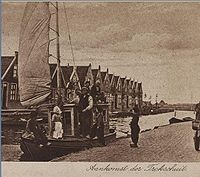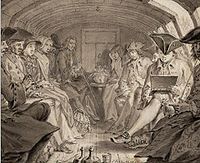
Trekschuit
Encyclopedia



Horse-drawn boat
A horse-drawn boat or tow-boat is a historic boat operating on a canal, pulled by a horse walking on a special road along the canal, the towpath.-United Kingdom:...
specific to the Netherlands
Netherlands
The Netherlands is a constituent country of the Kingdom of the Netherlands, located mainly in North-West Europe and with several islands in the Caribbean. Mainland Netherlands borders the North Sea to the north and west, Belgium to the south, and Germany to the east, and shares maritime borders...
where it was used for centuries as a means of passenger traffic between cities along trekvaarten, or tow-canals.
History
The first trekschuit 'sailed' in 1632 between AmsterdamAmsterdam
Amsterdam is the largest city and the capital of the Netherlands. The current position of Amsterdam as capital city of the Kingdom of the Netherlands is governed by the constitution of August 24, 1815 and its successors. Amsterdam has a population of 783,364 within city limits, an urban population...
and Haarlem
Haarlem
Haarlem is a municipality and a city in the Netherlands. It is the capital of the province of North Holland, the northern half of Holland, which at one time was the most powerful of the seven provinces of the Dutch Republic...
and could carry 30 passengers. The trekvaart or canal
Canal
Canals are man-made channels for water. There are two types of canal:#Waterways: navigable transportation canals used for carrying ships and boats shipping goods and conveying people, further subdivided into two kinds:...
was dug especially in a straight line to guarantee the shortest route. The passengers needed to step out and change boats in Halfweg, which means "halfway". This is how the town of Halfweg was formed. Because of the enormous success of this Haarlemmertrekvaart
Haarlemmertrekvaart
The Haarlemmertrekvaart is a canal between Amsterdam and Haarlem in the province of North Holland, the Netherlands. It was dug in 1631, making it the oldest tow-canal in Holland...
, the service was extended from Haarlem to Leiden in 1657.
In 1668 the first evening service was announced in the Haarlems Dagblad
Haarlems Dagblad
The Haarlems Dagblad is a regional newspaper in Haarlem, the Netherlands. It makes claim to being the newspaper with the oldest publishing history in the world, even if this claim is based on its merger with another title....
, enabling daily commuting to the growing metropolis of Amsterdam, which was becoming by that time more and more necessary for the (depressed) Haarlem economy:
By 1700 an extensive network of trekschuit- and ferry services linked all of the important cities in the coastal provinces of the Netherlands. Travel by trekschuit was reliable, comfortable and cheap. The speed was about 7 kilometers per hour, which was faster than walking, and more comfortable than by coach
Stagecoach
A stagecoach is a type of covered wagon for passengers and goods, strongly sprung and drawn by four horses, usually four-in-hand. Widely used before the introduction of railway transport, it made regular trips between stages or stations, which were places of rest provided for stagecoach travelers...
. Many foreigners praised the advantages of the system, leading to the introduction of canals such as the Erie canal
Erie Canal
The Erie Canal is a waterway in New York that runs about from Albany, New York, on the Hudson River to Buffalo, New York, at Lake Erie, completing a navigable water route from the Atlantic Ocean to the Great Lakes. The canal contains 36 locks and encompasses a total elevation differential of...
in the United States. The boats were pulled along by horse on a towpath
Towpath
A towpath is a road or trail on the bank of a river, canal, or other inland waterway. The purpose of a towpath is to allow a land vehicle, beasts of burden, or a team of human pullers to tow a boat, often a barge...
(in Dutch called jaagpad, named after the jager (chaser) which accompanied the horse).
The old tow-canal system that were once busy trekschuit routes became obsolete with the advent of the railway in the mid-19th century, many of which were built alongside the canals.
Canal travel
Many foreign travellers to the Netherlands came by boat. AmsterdamAmsterdam
Amsterdam is the largest city and the capital of the Netherlands. The current position of Amsterdam as capital city of the Kingdom of the Netherlands is governed by the constitution of August 24, 1815 and its successors. Amsterdam has a population of 783,364 within city limits, an urban population...
during the Dutch Golden Age
Dutch Golden Age
The Golden Age was a period in Dutch history, roughly spanning the 17th century, in which Dutch trade, science, military and art were among the most acclaimed in the world. The first half is characterised by the Eighty Years' War till 1648...
was the leading port city of Northern Europe and a major hub in the trekschuit network. Since the canals also functioned as the city's sewers, the smell of them in the summertime was bad. William Thomas Beckford
William Thomas Beckford
William Thomas Beckford , usually known as William Beckford, was an English novelist, a profligate and consummately knowledgeable art collector and patron of works of decorative art, a critic, travel writer and sometime politician, reputed to be the richest commoner in England...
, whose Dreams, Waking Thoughts, and Incidents is a published account of his letters back home in 1780 while on his Grand Tour
Grand Tour
The Grand Tour was the traditional trip of Europe undertaken by mainly upper-class European young men of means. The custom flourished from about 1660 until the advent of large-scale rail transit in the 1840s, and was associated with a standard itinerary. It served as an educational rite of passage...
of Europe, travelled from Ostend
Ostend
Ostend is a Belgian city and municipality located in the Flemish province of West Flanders. It comprises the boroughs of Mariakerke , Stene and Zandvoorde, and the city of Ostend proper – the largest on the Belgian coast....
, to Antwerp, to Haarlem
Haarlem
Haarlem is a municipality and a city in the Netherlands. It is the capital of the province of North Holland, the northern half of Holland, which at one time was the most powerful of the seven provinces of the Dutch Republic...
, and to Utrecht
Utrecht (city)
Utrecht city and municipality is the capital and most populous city of the Dutch province of Utrecht. It is located in the eastern corner of the Randstad conurbation, and is the fourth largest city of the Netherlands with a population of 312,634 on 1 Jan 2011.Utrecht's ancient city centre features...
by trekschuit, and wrote:
He switched his transportation to a coach from Utrecht to Spa
Spa
The term spa is associated with water treatment which is also known as balneotherapy. Spa towns or spa resorts typically offer various health treatments. The belief in the curative powers of mineral waters goes back to prehistoric times. Such practices have been popular worldwide, but are...
.
Legend of Boerhaave and Spinoza
In Samuel JohnsonSamuel Johnson
Samuel Johnson , often referred to as Dr. Johnson, was an English author who made lasting contributions to English literature as a poet, essayist, moralist, literary critic, biographer, editor and lexicographer...
's Life of Herman Boerhaave, the legend of Boerhaave and Spinoza is related that supposedly took place in 1688 or 1689, when Boerhaave graduated from Leiden University. This makes mention of the trekschuit as a 'common boat':
Passenger boat traffic in the Netherlands today
The rise of the steam locomotiveSteam locomotive
A steam locomotive is a railway locomotive that produces its power through a steam engine. These locomotives are fueled by burning some combustible material, usually coal, wood or oil, to produce steam in a boiler, which drives the steam engine...
in the 19th century caused the decline of the trekschuit between the major cities as a form of transport and today many of the oldest canals in congested parts of the country are defunct and no longer kept navigable by the Water board
Water board
A water board is a regional organisation that has very different functions from one country to another, ranging from flood control, water resources management, water charging and financing, and bulk water supply.-Philippines:The...
.
During World War II
World War II
World War II, or the Second World War , was a global conflict lasting from 1939 to 1945, involving most of the world's nations—including all of the great powers—eventually forming two opposing military alliances: the Allies and the Axis...
, a brief revival of the trekschuit occurred because of the scarcity of fuel for motorized transport. Since then, in Amsterdam the trekschuit has given way to the "museum boat" and "canal cruises" used exclusively by tourists. In the provinces, where the infrastructure has not been superseded by trains or highways, the old trekschuit canals are popular for water tourism
Water tourism
Water tourism is traveling by boat while on holiday, with the express purpose of seeing things meant for the water tourist. This can be traveling from luxury port to luxury port, but also landing a boat for lunch or other day recreation at specially prepared day boat-landings...
and many cities and towns are installing boat landings built specifically for pleasure boating. Restored trekschuits are chic venues for weddings or other parties in the summer, while larger antique barges are transformed into traveling hotels offering cruise vacations.

